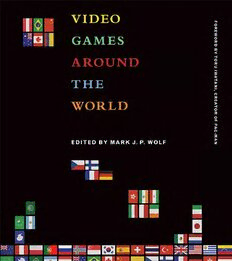
Video Games Around the World PDF
Preview Video Games Around the World
VIDEO GAMES AROUND THE WORLD VIDEO GAMES AROUND THE WORLD edited by Mark J. P. Wolf The MIT Press Cambridge, Massachusetts London, England © 2015 Massachusetts Institute of Technology All rights reserved. No part of this book may be reproduced in any form by any electronic or mechanical means (includ- ing photocopying, recording, or information storage and retrieval) without permission in writing from the publisher. MIT Press books may be purchased at special quantity discounts for business or sales promotional use. For information, please email [email protected] This book was set in Gentium Book Basic by Toppan Best-set Premedia Limited, Hong Kong. Printed and bound in the United States of America. Library of Congress Cataloging-in-Publication Data Video games around the world / edited by Mark J. P. Wolf ; foreword by Toru Iwatani. pages cm Includes bibliographical references and index. ISBN 978-0-262-52716-3 (pbk. : alk. paper) 1. Video games. 2. Video games — Cross-cultural studies. I. Wolf, Mark J. P. GV1469.3.V565 2015 794.8 — dc23 2014034381 10 9 8 7 6 5 4 3 2 1 CONTENTS Foreword ix T oru Iwatani Acknowledgments xv Introduction 1 M ark J. P. Wolf Africa 17 W esley Kirinya Arab World 29 R adwan Kasmiya Argentina 35 G raciela Alicia Esnaola Horacek, Alejandro Iparraguirre, Guillermo Averbuj, and Marí a Lujá n Oulton Australia 57 T homas H. Apperley and Daniel Golding Austria 71 K onstantin Mitgutsch and Herbert Rosenstingl Brazil 87 L ynn Rosalina Gama Alves vi CONTENTS Canada 105 Dominic Arsenault and Louis-Martin Guay China 119 Anthony Y. H. Fung and Sara Xueting Liao Colombia 137 Luis Parra and Global Game Designers Guild (GGDG) Czech Republic 145 P atrik Vacek Finland 159 F rans Mä y rä France 175 A lexis Blanchet Germany 193 Andreas Lange and Michael Liebe Hong Kong 207 Benjamin Wai-ming Ng Hungary 219 T amá s Beregi India 235 S ouvik Mukherjee Indonesia 249 Inaya Rakhmani and Hikmat Darmawan Iran 271 A hmad Ahmadi CONTENTS vii Ireland 293 D eborah Mellamphy Italy 305 E nrico Gandolfi Japan 319 J ennifer deWinter Mexico 345 H umberto Cervera and Jacinto Quesnel The Netherlands 359 C hristel van Grinsven and Joost Raessens New Zealand 377 M elanie Swalwell Peru 393 A rturo Nakasone Poland 399 P . Konrad Budziszewski Portugal 425 N elson Zagalo Russia 439 A lexander Fedorov Scandinavia 451 L ars Konzack Singapore 469 P eichi Chung viii CONTENTS South Korea 495 P eichi Chung Spain 521 M anuel Garin and Ví c tor Manuel Martí n ez Switzerland 535 M atthieu Pellet and David Javet Thailand 545 S ongsri Soranastaporn Turkey 565 C etin Tuker, Erdal Y ıl maz, and Kursat Cagiltay United Kingdom 579 T ristan Donovan United States of America 591 M ark J. P. Wolf Uruguay 609 G onzalo Frasca Venezuela 613 T homas H. Apperley Contributors 629 Index 645 FOREWORD T oru Iwatani translated by Bryan Hikari Hartzheim 1 On the Global Expansion of Games Video games today are often played largely for personal use on smartphones, but if we look at the history of gaming, we see that people played games very differently, in arcades — amusement centers that were once a staple of every city. These arcades date back to the coin-operated Edison parlors that first emerged in the United States during the 1890s. In these amusement centers, customers would insert coins into machines for music and visual entertainment. If we look back at the changes that media such as computers, phones, and video games have undergone, we can see how computers migrated from research centers to the home, where PCs (personal computers) are now just another medium for personal use. As call boxes were once the exclusive domain of companies, telephones became commonplace in the home and are now personal terminals of mobile information. Video games are no different, moving from citywide arcades to homebound console systems so that the current iteration of mobile phone gaming is simply part of the developmental process. The online revolution, in conjunction with the development of gaming on small and portable devices, accelerated the process of popularizing video games, and I believe this is a significant reason for the expansion of video games around the world. In 1972, when the American electronics company Atari introduced P ONG , which extended inventor Ralph Baer ’ s idea of interactive play on CRT-type televisions (which were, in and of themselves, worthy of admiration), the sen- sation also created a media revolution. 2 The Role of the Games Industry Video games differ from other manufactured goods in that they are the rare product to simultaneously be electrical, mechanical, and works of art; they aggregate a range of ideas from the fields of engineering to literature to art to psychology, and they provide society with a necessary cultural tool of “ play. ” Games them- selves are formed broadly by the characteristics of play that date back as far as civilization has existed. This
